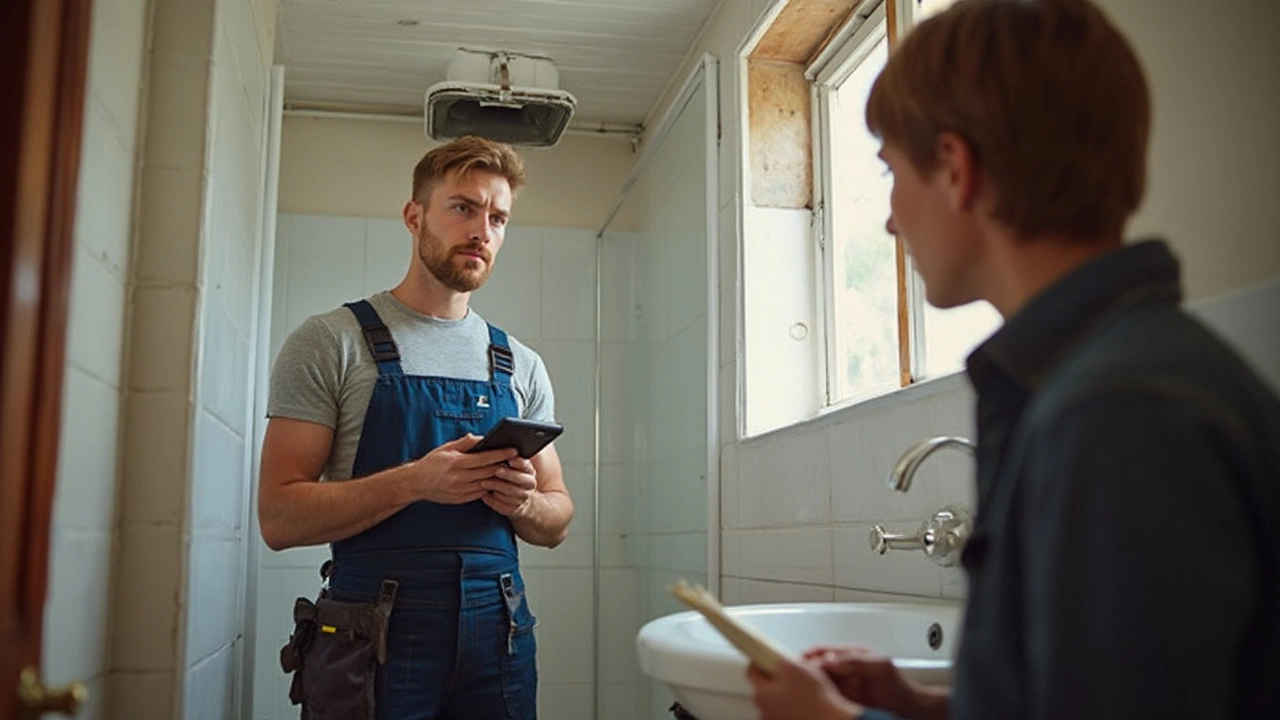If your bathroom extractor fan just hums and collects dust, you’re not alone. These little workhorses go unnoticed until the room fills with steam or mildew creeps onto the ceiling. But when they stop working, it’s not always obvious who to call—or whether it’s even worth fixing.
First thing, don’t mess with electrical stuff if you’re not comfortable. Extractor fans hook into mains power, which means mistakes can lead to a lot more than a broken fan. Most people should call someone for help—usually an electrician, but sometimes a handyman can get the job done, depending on the problem.
Before picking up the phone, it helps to know what can go wrong. Fans get clogged with dust or the grille jams up. Sometimes the pull-cord breaks, or the switch fries. If it’s not turning on at all, it could be a fuse, a wiring issue, or the whole unit might have kicked the bucket.
- How to Spot Extractor Fan Problems
- Electrician vs. Handyman: Who Should You Hire?
- Typical Fixes and When to Replace
- Tips for Dealing With Bathroom Fan Repairs
How to Spot Extractor Fan Problems
The bathroom extractor fan usually gets ignored—until it starts acting up. Signs there’s a problem aren’t always obvious, and a dodgy fan can sneak up on you. You might only notice when the mirror stays foggy after a shower, or your bathroom always has a damp smell no matter how much you scrub.
One clear warning sign is noise. If your fan gets louder, screeches, bangs, or rattles, something’s wrong inside. Fans should hum quietly; any grinding or buzzing often means dust is jamming the blades, or a part’s come loose. If you hear a click and it doesn’t switch on at all, you might have a blown fuse, a wiring issue, or the fan motor has burned out.
- Check if the fan grill is clogged with dust and fluff—a clogged grill blocks airflow, making the fan much less effective.
- Test the suction by holding a tissue up to the grill. If it barely sticks, your fan's struggling to pull air.
- Look for mildew or water stains around the fan and on the ceiling. Moisture stuck in the room means your extractor fan isn’t clearing the air properly.
- If your fan is connected to a light switch or pull cord, check if either is faulty. If flipping the switch does nothing, try another room’s fan or light to rule out a bigger electrical problem.
It’s wild how much gunk builds up in these things. When I checked mine, I found a lovely blanket of dust Rowan could have made a snowman out of. Regular checks and a quick vacuum can keep you from bigger repairs down the line.
Knowing these warning signs can save you from moldy walls and pricey repairs. If your extractor fan repair is overdue, these checks will tell you if it’s something simple or time to call in the pros.
Electrician vs. Handyman: Who Should You Hire?
When your bathroom extractor fan gives up, the classic question is: do you call in an electrician, or is a handyman enough? The answer depends on what’s actually wrong with your fan—and how safe you want the job to be.
An extractor fan repair might seem simple, but remember, these fans are wired directly into your home's electrical system. That means if there’s anything related to wiring, fuses, or switches, you want a qualified electrician. Electricians have the official training, and in the UK, they’re NICEIC or NAPIT registered for a reason. That’s not just paperwork—it’s your best chance to avoid dodgy wiring or shock risks.
But not every fan problem is electrical. Sometimes, it’s a blocked vent or a cracked cover. That’s typical handyman territory. Handymen are great for mechanical fixes, cleaning, replacing broken grilles, or even swapping out a simple fan unit. Just make sure they’re happy working around electrics—some won’t touch anything wired.
Cost often comes up. Electricians usually charge more per hour since they’re certified for jobs that could become safety hazards. A typical electrician callout might range from £60 to £120, while a handyman could charge far less, especially if you just need a cleaning or part swap.
| Task | Best Choice | Typical Cost |
|---|---|---|
| Wiring or Switch Issues | Electrician | £60-£120 (per hour) |
| Fan Cleaning or Grill Replacement | Handyman | £30-£60 (per hour) |
| Full Unit Replacement | Electrician or Handyman* (depends on wiring complexity) | £80-£200 (all in, including new fan) |
*If new wiring is needed or there’s a risk of water hitting electrics, always stick with an electrician.
To sum it up: basic cleaning and cosmetic stuff, a handyman is fine. If it’s electrical, use an electrician. I once tried to swap a bathroom fan myself. Ended up tripping the whole house fuse. Lesson learned: if in doubt, call a pro.

Typical Fixes and When to Replace
When your bathroom extractor fan repair project pops up, the usual suspects are pretty common. Odd noises, weak airflow, or a fan that just doesn’t switch on—these are classic signs something’s up. If your fan buzzes but doesn’t spin, the motor might be burned out. If it makes grinding or rattling sounds, worn bearings or dust build-up could be the reason. Lots of folks don’t realize that even a half-inch of dust can cut airflow by nearly 20%.
Before reaching for your wallet, check these simple fixes:
- Clean the grill and blades. Most models have snap-off covers—take them off and gently wash away gunk.
- Look at the wiring (only if you know what you’re doing). Loose wires can often explain why the fan won’t start.
- Swap out a worn pull cord. This takes basic tools and is cheap to do yourself.
- Change a fuse or circuit breaker if the fan gets no juice at all.
Once you’ve tried these and the fan’s still limping along, it might be time to call it quits. Electricians say if the motor’s dead, or if parts like switches or timer circuits are cooked, it’s usually better to replace than repair—especially for older fans. The guts of most budget fans aren’t worth the labor or cost to overhaul.
“If a bathroom fan is over ten years old and stops working, replacing usually makes more sense than trying to repair—new models are safer, quieter, and more energy-efficient.” —Home Repair Network
A new basic fan can cost between $30-80 (just for the unit), but high-end silent models can run up to $200. Professional installation averages $100-250, depending on wiring and location. Here’s a quick breakdown of typical repair vs. replacement costs:
| Issue | Average Repair Cost | Average Replacement Cost |
|---|---|---|
| Cleaning & Basic Fix | $0-50 | — |
| Wiring or Switch | $50-120 | — |
| Motor Failure | $80-200* | $130-300** |
*If parts are available, which is rare for older fans. **Includes basic fan and labor.
It’s not always about the cheapest fix. If your bathroom’s always muggy or your fan sounds like it’s chewing gravel, do your wallet a favor and swap it out. Newer models are super efficient, better at clearing out steam, and you won’t be embarrassed when guests ask about the noise in your bathroom.
Tips for Dealing With Bathroom Fan Repairs
Dealing with a busted bathroom fan is annoying, but you can save time and money if you know a few practical steps. First, always check if the fan is still under warranty before calling anyone—most brands offer at least a one-year cover. Make a note of the model and snapping a picture of the label helps, especially if you’re not sure what you’re dealing with. You’d be surprised how many times pros get stumped just because they don’t know the exact model.
When hiring someone, use these steps to avoid hassle or overpaying:
- Get a couple of quotes. Prices for extractor fan repair swing a lot, but most jobs fall between £50–£120 in the UK, depending on complexity.
- Ask if they have experience fixing your type of fan—inline, wall, or ceiling fans take different approaches.
- If moisture marks are on the wall or ceiling, mention it up front. Leaks often point to ducting or blockage, not just the fan itself.
- Always request a basic safety check—sometimes a drippy vent signals another bigger issue, like dodgy wiring.
- If the whole system looks ancient (older than 10 years), replacing might be smarter than fixing. New models draw 70–80% less power than ancient ones, so they’re cheaper long-term.
Here’s a table with quick stats and tips to keep in mind:
| Typical Issue | Fastest Fix | DIY Risk Level | Pro Cost Range (UK) |
|---|---|---|---|
| Fan not running at all | Check fuse/switch | High (wiring involved) | £70–£120 |
| Loud noise | Clean fan/duct | Low to Medium | £50–£80 |
| Poor airflow | Clean or clear blockage | Medium | £60–£90 |
| Broken switch or cord | Replace switch/cord | Medium | £70–£100 |
If you’re even a little bit unsure about electrics, don’t take the risk. Just turn the power off at the breaker and wait for a pro. Your future self (and your wall) will thank you for playing it safe.


